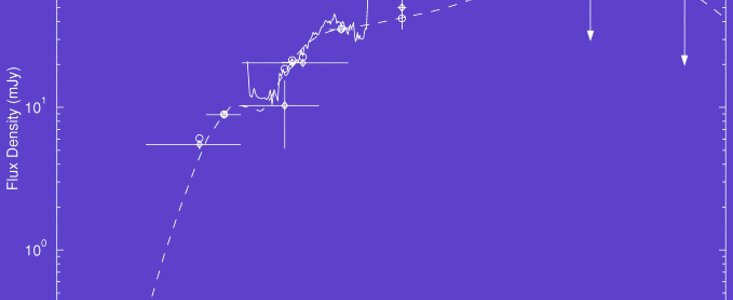OSCIR Unveils Rich Dust Content in the Second Most Metal Deficient Galaxy Known
9 Octubre 2002
SBS 0335-052 is a gas-rich dwarf galaxy at a distance of 170 million light-years (52 Mpc). It is the second most metal-poor galaxy known, with a heavy metal content only 1/40th that of the Sun. Such a low metallicity means that this galaxy contains significantly lower quantities of the heavy elements produced by the process of nucleosynthesis in stars. This lack of metals could be because the galaxy is very young. Another possibility is that SBS 0335-052 is an old galaxy that has experienced a very low star formation rate throughout its lifetime.
Canadian Ph. D. student Stephanie Plante (Universite Laval, Quebec) and French astronomer Marc Sauvage (Service d'Astrophysique, Saclay) used OSCIR on Gemini North to image SBS 0335-052 in the mid-infrared at 10.8 and 21 microns. Their images revealed a massive supercluster of young stars with a total mass equivalent to 2 million times the mass of the Sun in the core of the galaxy. It is estimated that the age of this cluster is 5 millions years or less.
The Gemini investigators were able to infer the properties of the dust-hidden cluster by analyzing the properties of the interstellar dust surrounding these stars. This is possible since the dust 'processes' the stellar radiation produced by the stars by absorbing the ultra-violet and optical light from embedded stars and then re-radiating it in the mid-infrared. Interstellar dust particles are small solid particles made of the most common heavy elements like carbon, silicates, ices and other molecules in solid form.
Combining the Gemini observations with those made by the ISOPHOT instrument aboard the Infrared Satellite Observatory in the far infrared at 60, 65 and 100 microns, Plante and Sauvage have used the software DUSTY to model both the star cluster and its surrounding dust. The two flux points at 10.8 and 21 microns derived from the OSCIR images were crucial in constraining some of the key model parameters which allowed them to construct a detailed model of the dust properties.
These Gemini results are interesting because they indicate that the paucity of metals did not preclude SBS 0335-052 from forming 105 solar masses of dust. The unresolved N band Gemini image and calculations using the DUSTY model show that there is enough dust to hide the massive star cluster from view in the optical. Plante and Sauvage estimate the amount of extinction toward the cluster to be equivalent to 30 magnitudes in the V band, which is why the region is totally undetectable at optical wavelengths. Interestingly, this is very similar to the amount of extinction that we observe toward the center of the Milky Way galaxy. The two million solar masses of young stars are packed in a region not larger than 10 pc (~30 light-years) across.
The presence of such a high density of stars implies a high density of radiation. The ultraviolet radiation emitted by the cluster is intense enough to destroy the smallest dust molecules (PAH) and even the smallest grains (VSM) present in its near environment. Only the biggest dust grains (around 1 micron or slightly less) survive. The Q band (21 micron) observation with OSCIR allowed the researchers to ascertain that even though there are no PAH emission features seen, there is some carbonaceous dust present in SBS0335-052's massive stellar cluster.
Finally, Plante and Sauvage caution that if dust-enshrouded super-star clusters are commonly associated with a starbursting environment, the star formation rate deduced by looking at the rest-frame optical or ultraviolet portion of the spectrum should be viewed with caution.
Plante and Sauvage have published their work in The Astronomical Journal, October 2002, vol. 124, pp. 1995-2005.
Notes
[1] The University of Florida's OSCIR (Observatory Spectrometer and Camera for the Infrared) mid-infrared imager/spectrometer, which was built with funding from the National Science Foundation and NASA.



